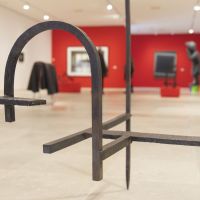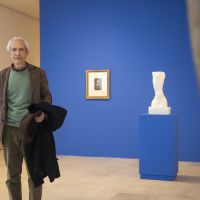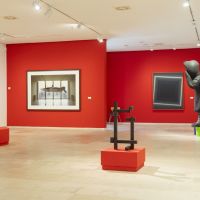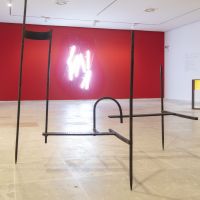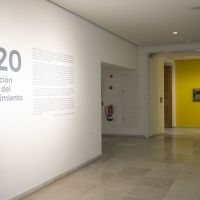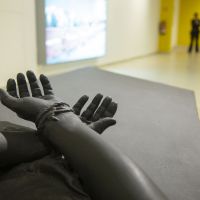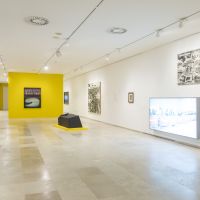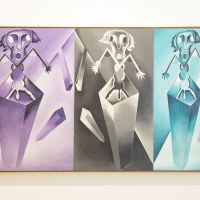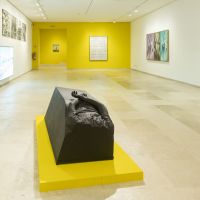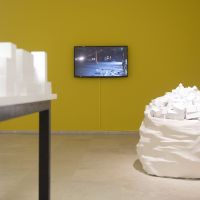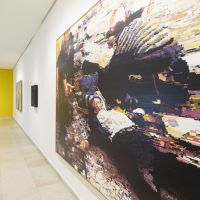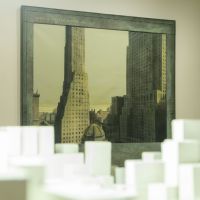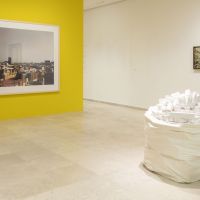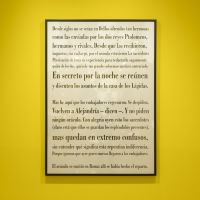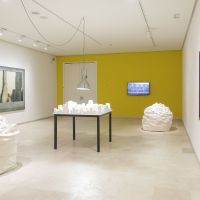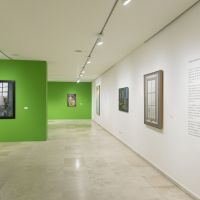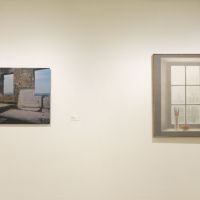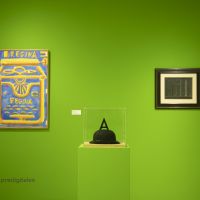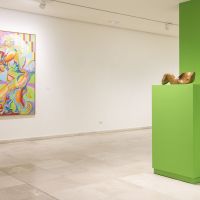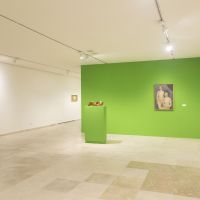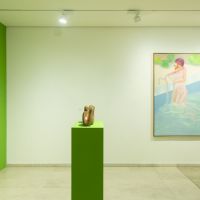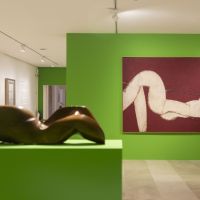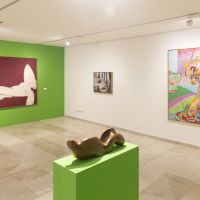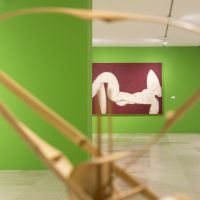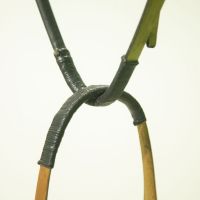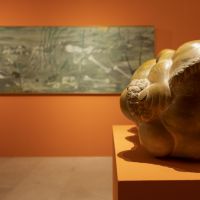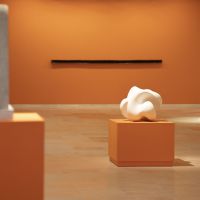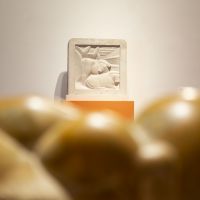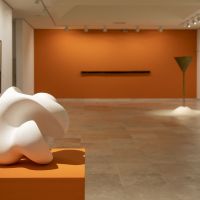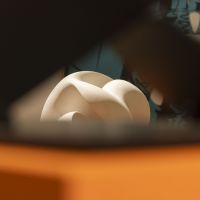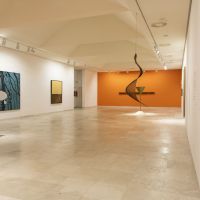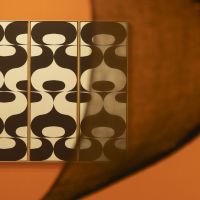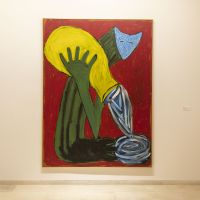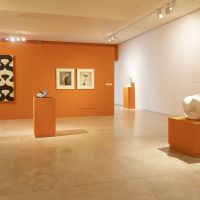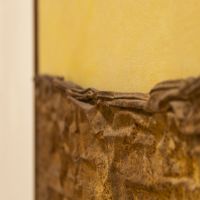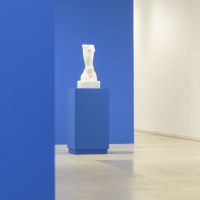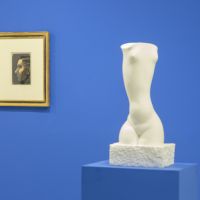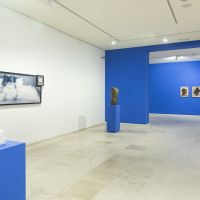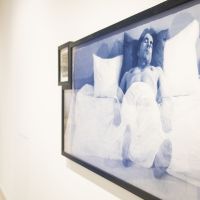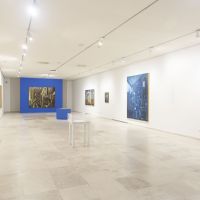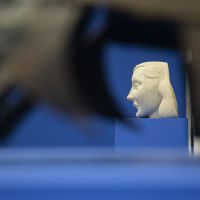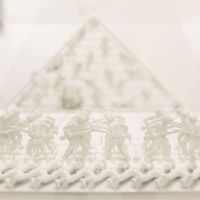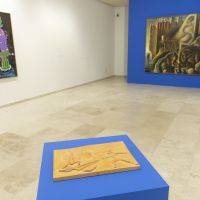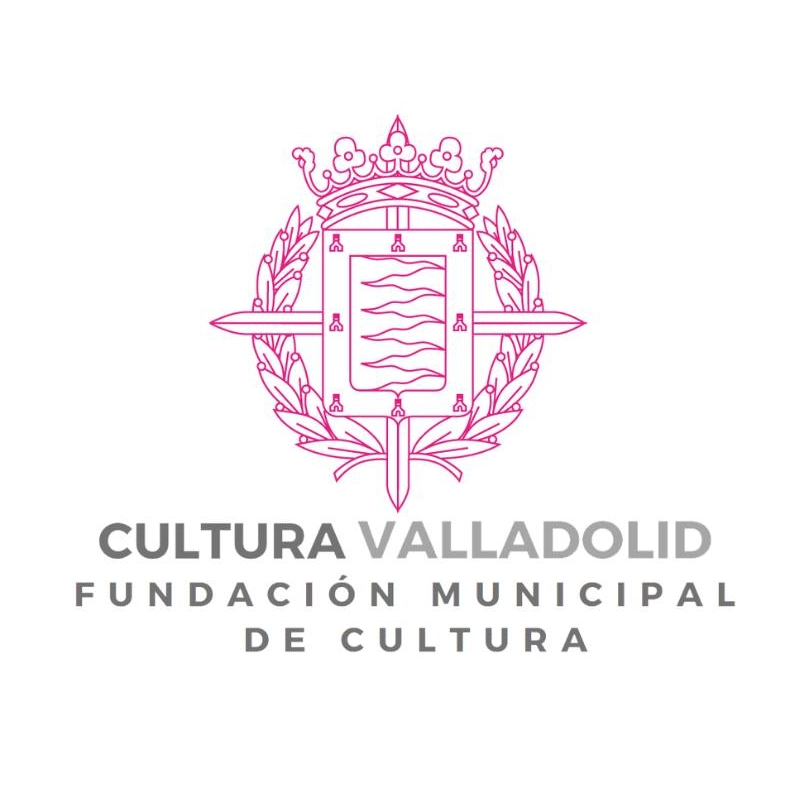2120
La Colección después del Acontecimiento

[English version below]
Después de varias ocasiones en las que la Colección se ha presentado siguiendo criterios ortodoxos, ya fueran cronológicos o estilÃsticos, proponemos esta nueva lectura, hipotética y en clave futurista. Un ejercicio de imaginación que pretende extraer de las obras nuevos significados, los que aparecen si las miramos desde una cierta distancia cultural. O temporal.
La crisis climática, cuyas primeras manifestaciones ya percibimos, tendrá graves consecuencias tanto en el medio natural como en la especie humana. CientÃficos y dirigentes polÃticos han fijado el horizonte de sus previsiones en el año 2100. Para esa fecha y con el objetivo de evitar una previsible catástrofe civilizatoria, el Acuerdo de ParÃs de 2015 estableció un plan de acción mundial para limitar el calentamiento global por debajo de 2 ºC. Conseguirlo implicará una profunda transformación de nuestro modo de vida. A dÃa de hoy no tenemos certeza alguna de conseguirlo. Al conjunto de importantes fenómenos socioeconómicos, culturales y naturales que van a tener lugar, resultado tanto del Cambio Climático como de su contención, podemos llamarlo, con un eufemismo genérico, El Acontecimiento.
2120. La Colección después del Acontecimiento es una selección de obras de la Colección Arte Contemporáneo, con sede en el Museo Patio Herreriano, realizada por el historiador José MarÃa Parreño, que ha buceado en los fondos de la que es considerada una de las más colecciones relevantes de España. La exposición nos sitúa casi exactamente en el escenario de todas esas proyecciones. Con un optimismo al que no podemos renunciar, pensamos que en esa fecha será posible y tendrá sentido mostrar, como un evento del mayor interés, esta extraordinaria colección de arte español.
Asà pues, invitamos a los espectadores a trasladarse al año 2120 y mirar desde allÃ, retrospectivamente, las manifestaciones artÃsticas del siglo XX y los albores del XXI. Las encontrará ordenadas y presentadas con criterios que pertenecen a una cultura futura, distinta de la nuestra, con otros valores y otras preocupaciones. Asà solemos ver nosotros las obras de arte de épocas anteriores, a través de nuestra concepción del mundo, que muchas veces les asigna un significado diferente a aquél con que fueron creadas.
La llamaron Humanidad
La dignidad de un rostro - El cuerpo presente - Usos y vÃnculos sociales
De 1900 a 2000, la población mundial pasó de 1.300 a 6.100 millones. Considerado el centro del universo, su dueño y señor, el ser humano ocupa el papel principal en la cultura, el arte y las representaciones. El rostro, emblema del cuerpo y sinónimo de identidad, fue un tema frecuente en pintura y escultura hasta mediados del siglo XX y luego empezarÃa a escasear. Cuerpo y rostro, antes de la expansión de la genética estética y de los correctores automáticos de rasgos, eran genuinos y tradicionalmente se les consideraban expresión de la personalidad.
Como podremos ver, la socialización se realizaba personalmente (y mediante correspondencia y telefonÃa analógicas). Los lugares de interacción eran la familia clásica cisheteropatriarcal, los centros educativos y de trabajo, los desplazamientos…
Se mantenÃan valores humanistas de apoyo y solidaridad, vehiculados también por el arte. Se produjo un desarrollo sin precedentes en el reconocimiento y defensa de los derechos humanos, destacando el final del dominio sobre colonizados, racializados y mujeres. Sin embargo, en el siglo XX acaecieron más de un centenar de guerras convencionales, que provocaron alrededor de 110 millones de vÃctimas, 65 millones sólo en la denominada Segunda Guerra Mundial. En España, entre 1900 y 2000, la población aumentó de 18 a 41 millones de habitantes. La llamada guerra civil causó 700.000 muertes (2,8 % de la población). Pero la paz podÃa ser igualmente destructiva. Entre 2003 y 2018, periodo en que la recogida de datos es fiable, en nuestro paÃs se produjeron 1.000 muertes por violencia de género, 42.200 por accidentes de tráfico y 800.000 por enfermedades asociadas al consumo de un producto cuya venta era monopolio del estado.
Souvenirs de la Tierra
Aguas - Horizontes - Animales con vida - Lo orgánico es sexy
La destrucción del medio natural debida a la actividad humana sufrió una brutal aceleración desde 1950. En lo que quedaba de siglo, por ejemplo, en América del Norte desaparecieron 2.900 millones de pájaros. En España, entre los años 2000 y 2019, 95 millones, 15 de ellos golondrinas. Una muestra de lo que podrÃa ser en pocos años más la Sexta Extinción, que romperÃa la malla de relaciones que sostiene la vida. El proceso universal de desplazamiento del campo a la ciudad y la proliferación de la tecnologÃa, fueron lenta pero inexorablemente extrañando al ser humano de su condición natural. Sin embargo, la naturaleza siguió idealizada como depositaria de valores como la salud y la belleza y, ciertamente, sus fenómenos y elementos estaban profundamente entrelazados en el lenguaje y la simbologÃa. La naturaleza quedarÃa pues arrinconada en zoológicos y parques naturales y celebrada en las artes. A finales del siglo se empezaron a reconocer ciertos derechos animales, iniciando el proceso que llevarÃa a la legislación actual. En 2015, el peso de los seres humanos y sus animales domésticos representaba el 96% del peso total de la vida animal y sólo el 4 % restante era salvaje.
Un elemento como el agua, recurso básico para la vida y sÃmbolo de vigencia universal, se repite una y otra vez en las representaciones, o bien como homenaje o bien como estrategia compensadora ante su progresiva escasez. Otro tanto sucede con el horizonte, que aparece en una proporción que sugiere una importancia de la que carece para nosotros.
La fascinación por las formas orgánicas y por la pervivencia de patrones idénticos en los diferentes órdenes naturales, muestra afinidad y acaso una veneración inconsciente por los rasgos de lo vivo.
Antes del Acontecimiento
Fenómenos extremos – Masas y bajas - Metrópolis
A comienzos de siglo XX vivÃa en ciudades el 13 % de la población mundial, mientras que en el año 2000 esa cifra alcanzaba el 49 %. Con 29,4 millones de habitantes, Tokio era entonces la ciudad más poblada. El desplazamiento desde las áreas rurales fue consecuencia de la industrialización, pero durante la mayor parte del siglo el imaginario social las identificaba con el progreso y la libertad personales. Sin embargo, el hacinamiento, el tráfico y la contaminación, añadidos a la pobre planificación urbanÃstica dieron lugar a una crisis del modelo de ciudad. Al margen de las guerras, dirigidas por profesionales, fue en las ciudades donde se desarrollaron las insurrecciones, la violencia polÃtica y los ataques terroristas. La desigualdad, la glorificación de la violencia como entretenimiento, el descrédito de los valores comunitarios, la ilegalidad del tráfico de drogas o la creciente presión migratoria agravaron la situación.
La naturaleza, que parecÃa estar definitivamente dominada, empezó a manifestarse a finales del siglo con una virulencia que obligó a recordar que dependemos absolutamente de ella. Su causa última, el calentamiento global producido por la actividad humana, habÃa sido dada a conocer al público en 1988. El primer acuerdo internacional para su control, la Cumbre de la Tierra, tuvo lugar en 1992 y es el remoto antecedente de la gran transformación en todos los órdenes que separa nuestro siglo de todos los anteriores.
A comienzos del siglo XXI, la consolidada creencia en el progreso indefinido de la civilización empieza a ponerse en cuestión como no habÃa sucedido en toda la Edad Moderna.
Vieja cultura moderna
Dispositivos predigitales - Ventanas -Voyeurismo - Madera, materia madre
El libro y la escritura se consideran los vehÃculos proverbiales de creación y transmisión de la cultura moderna. La letra impresa ostentaba una autoridad indiscutible. Los sucesivos movimientos disidentes (dadá, revolución cultural china, contraculturas del 68, punk) fueron con el tiempo absorbidos por el mercado como marcas.
En la pintura, el cobijo y el confort en un nivel que nunca antes habÃa gozado la especie humana, se plasmó en habitaciones marcadamente separadas del exterior. La ventana, el marco y en ocasiones la cuadrÃcula, acotan y racionalizan la mirada hacia el entorno, emblematizando un entendimiento no complejo de la realidad, deficiente en comparación con las estructuras disipativas hoy en uso.
La visualidad ha sido el medio de conocimiento del mundo por excelencia. También de su dominio desde una perspectiva colonizadora y patriarcal. No puede por menos que resultar llamativo el hecho de que la totalidad de los desnudos de la colección sean femeninos y que todos hayan sido realizados por varones.
Merece una mención especial la presencia de varias obras realizadas en madera. Hay ue tener en cuenta que antes de la Prohibición y durante cientos de siglos, la madera fue sobreabundante y su uso indiscriminado. Su misma etimologÃa la remite al término latino materia, pues en efecto, lo fue por excelencia desde el principio mismo de la civilización.
La era eléctrica
Máquinas veloces - El arte del Antropoceno
El formidable desarrollo de la sociedad industrial arrancó con mano de obra esclava y luego con un proletariado explotado sin distinción de sexo ni edad. Pero despegó finalmente gracias a los combustibles fósiles, cuyas prestaciones energéticas multiplicaban la capacidad humana para transformar el mundo. Por tanto, no es de extrañar que ya los primeros movimientos artÃsticos del siglo XX, como el futurismo italiano o el constructivismo soviético elogiaran la máquina y se deleitaran con la velocidad, sintetizando el imaginario social caracterÃstico del periodo. Lo paradójico fue que la utilización masiva y continuada de dichos combustibles terminó por crear las condiciones del colapso de la civilización que habÃan ayudado a crear. La industria, el transporte, la agricultura y la ganaderÃa industriales incrementaron sin descanso el consumo energético. Si desde 1750 hasta comienzos del siglo XXI se habÃan emitido 1.578 gigatoneladas de CO2, desde 1946 se emitieron 1.376, el 87 % del total. Sin embargo, no todos los paÃses contaminaron por igual: a finales del siglo XX, un 20 % de la población consumÃa el 80% de los recursos y era responsable del 75% de las emisiones.
Los analistas se vieron en la necesidad de manejar un término para señalar el impacto trastornador de la Humanidad sobre la totalidad el planeta. A esto alude el llamado Antropoceno, cuyo inicio suele fijarse en 1945, cuando se detonó la primera bomba atómica y sus isótopos radioactivos se extendieron indeleblemente por la atmósfera. Las obras que se presentan atrevidamente como propias de esta nueva era son precisamente ejercicios de un virtuosismo técnico que hace gala de un uso sin restricciones de la electricidad y los materiales propios de la industria pesada.
José MarÃa Parreño
Comisario de la exposición
2120. The Collection after the Event
After presenting the Collection on various different occasions following orthodox criteria, whether chronological or stylistic, we are now proposing a new reading, both hypothetical and futuristic. It is an exercise in imagination which aims to bring out new meaning in the works of art, meanings that appear if we look at the pieces from a certain distance in culture. Or in time.
The climate crisis, whose first manifestations we are already feeling, will have grave consequences in both the natural environment and the human species. Scientists and political leaders have fixed 2100 as the horizon for their predictions. For this date, with the purpose of avoiding a foreseeable catastrophe in civilization, the Paris Agreement from 2015 established a worldwide action plan to keep global warming down to under 2º C. Achieving this implies a profound transformation in the way we live. As of today there is absolutely no certainty that we will achieve this goal. We could, with a generic euphemism, call the series of significant socioeconomic, cultural and natural phenomena that are going to take place as a result of both Climate Change and its containment, the Event.
2120. The Collection after the Event is an important selection of works belonging to the Colección Arte Contemporáneo, hosted by Museo Patio Herreriano, that has been curated by Art Historian José MarÃa Parreño. The show locates us almost exactly in the scenario of all these projections. With an optimism we cannot ignore, we think that on this date it will be possible and it will make sense to exhibit this extraordinary collection of Spanish art as an event of major interest.
So we are inviting viewers to travel forwards in time to 2120 and to look back from there at the artistic manifestations of the twentieth century and the dawn of the twenty-first. You will find them in a nice tidy order, presented under criteria that belong to a future culture, different from our own, with different values and different concerns. This is how we tend to look at works of art from previous times, through our own conception of the world, which very often endows them with a meaning that is not the one they were created with.Â
The called it Humanity
The dignity of a face – The body present – Social habits and links
From 1900 to 2000, the world’s population grew from 1.3 to 6.1 billion. Believed to be the centre of the universe, its lord and master, human beings played the main role in culture, art and depictions. The face – the emblem of the body and the synonym of identity – was a common topic in painting and sculpture up to the mid-twentieth century, and thereafter fell into disuse. The body and the face, before the expansion of aesthetic genetics and automatic feature correctors, were genuine and were traditionally considered to be the expression of personality.
As we will be able to see, socialization was done in person (by means of correspondence and analogue telephones). The places of interaction were the classical cisheteropartiarchal family, schools, universities and work centres, journeys…
There were humanist values of support and solidarity, also articulated by art. There was a development without precedent in the acknowledgement and defence of human rights; we could highlight the end of power over the colonized, the racialized and women. The twentieth century also saw, however, more than a hundred conventional wars, which produced around 110 million victims, 65 million of them in just what is known as the Second World War. In Spain, from 1900 to 2000, the population grew from 18 to 41 million people. The so-called Civil War caused 700,000 deaths (2.8% of the population). Peace could be equally destructive. From 2003 to 2018, a period in which data collection is reliable, there were a thousand deaths from gender violence in our country, 42,200 from traffic accidents and 800,000 due to illnesses related to the consumption of a product whose sale was a state monopoly.
Souvenirs of Planet Earth
Water - Horizons – Live animals – Organic is sexy
The destruction of the natural environment due to human activity underwent a drastic increase after 1950. In the rest of the century, for instance, 2.9 billion birds disappeared in North America. In Spain, from 2000 to 2019, the figure was 95 million, 15 million of them swallows. This is just an example of what in a few years could be the Sixth Extinction, which would tear apart the network of relationships that sustains life. The universal process of displacement from the countryside to the city and the proliferation of technology have slowly but surely taken human beings out of their natural condition. Nature, however, has still been idealized as the depository of values such as health and beauty, and its phenomena and elements have of course been profoundly interlinked in language and symbology. Nature was limited to zoos and natural parks, and celebrated in the arts. Towards the end of the century certain rights were acknowledged for animals, initiating the process that led to current legislation. In 2015, human beings and their pets accounted for 96% of the whole of animal life, while only the other 4% was wildlife.
An element such as water, a basic resource for life and a universal symbol, is repeated time and again in the depictions, as either a tribute or a strategy to compensate its growing scarcity. The same thing happens with the horizon, which is shown in a proportion which suggests it was much more important than it is for us.
The fascination for organic forms and the survival of identical patterns in the different natural orders show an affinity and possibly an unconscious veneration of the characteristics of what is alive.
Before the Event
Extreme phenomena – Masses and casualties - Metropolis
In the early twentieth century 13% of the world’s population lived in cities, while in 2000 the figure had gone up to 49%. Tokyo was the largest city in the world with 29.4 million inhabitants. Migration from rural areas was the consequence of industrialization, although for most of the century the social imagery identified cities with progress and personal freedom. Overcrowding, traffic and contamination, however, added to poor town planning gave rise to a crisis in the model of cities. Besides wars, run by professionals, it was in cities where uprisings, political violence and terrorist attacks all took place. Inequality, the glorification of violence as entertainment, the loss of community values, the illegality of drug trafficking and the growing migratory pressure all made the situation even worse.Â
Nature, which seemed to have been completely mastered, started to show herself at the end of the century with a raw power which forced us to remember that we depend absolutely on her. The public were first made aware of the ultimate cause – global warming produced by human activity – in 1988. The first international agreement to keep it under control, the Earth Summit, was reached in 1992 and is the remote ancestor of the great transformation in all spheres that separates our century from all previous ones.
In the early twenty-first century, the consolidated belief in the indefinite progress of civilization was questioned like it never had been before in the whole Early Modern Age.
Old modern culture
Predigital devices – Windows -Voyeurism – Wood, the mother material
Books and writing are considered to be the proverbial vehicles of the creation and handing down of knowledge. The printed letter boasted an indisputable authority. Successive dissident movements (Dada, the Chinese Cultural Revolution, the countercultures of 1968, punk) were all in time absorbed by the market as trademarks.
In painting, shelter and comfort took shape at a level never before enjoyed by the human species in rooms clearly separated from the exterior. Windows, frames and at times the grid limit and rationalize the gaze onto the environment, emblematizing a simple understanding of reality, deficient in comparison to the dissipating structures in use today.
Visuality was the means of knowledge in the world par excellence, and of the mastery thereof from a colonizing and patriarchal perspective. It is noteworthy in the extreme that all the nudes in the collection are of women and that all them were painted by men.
The presence of various works of art made of wood deserves special attention. We should not forget that before the Prohibition and for hundreds of centuries, wood was abundant and was used indiscriminately. The etymology of the word in Spanish (madera) comes from the same Latin term for material, as it was the material par excellence from the very beginning of civilization.
The electric age
Fast machines – The art of the Anthropocene
The huge development of the industrial society started off with slave labour and then an exploited proletariat, with no distinction of sex or age. It finally took off thanks to fossil fuels, whose energy benefits multiplied human capacity for transforming the world. It is therefore not surprising that the first artistic movements in the twentieth century, such as Italian futurism and Soviet constructivism, should praise machines and find joy in speed, synthesizing the social imaginary that was characteristic of the period. What was paradoxical was that the massive and ongoing use of these fuels ended up by bringing about the conditions for the collapse of the civilization it had helped create. Industry, transport, agriculture and industrial livestock farming ceaselessly increased the consumption of energy. From 1750 to the beginning of the twenty-first century 1,578 gigatons of CO2 were emitted, and from 1946 the figure was 1,376, 87% of the total. Not all countries contaminated at the same rate, however: at the end of the twentieth century, 20% of the population were consuming 80% of the resources, and were responsible for 75% of emissions.
Analysts had to come up with a term to define the destructive impact of Humanity on the planet as a whole. This is what the so-called Anthropocene refers to; the beginning of this period is usually set at 1945, when the first atomic bomb was dropped and its radioactive isotopes spread indelibly through the atmosphere. The works of art that are daringly shown as inherent to this new epoch are precisely exercises in a technical virtuosity that makes a show of the unrestricted use of electricity and the materials inherent to heavy industry.
José MarÃa Parreño
Curator of the exhibition

